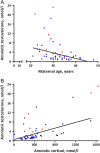Maternal and female fetal testosterone levels are associated with maternal age and gestational weight gain
- PMID: 28705923
- PMCID: PMC5597951
- DOI: 10.1530/EJE-17-0207
Maternal and female fetal testosterone levels are associated with maternal age and gestational weight gain
Abstract
Objective: Prenatal androgen exposure has been suggested to play a role in polycystic ovary syndrome. Given the limited information on what maternal characteristics influence maternal testosterone levels, and the even less explored routes by which female fetus androgen exposure would occur, the aim of this study was to investigate the impact of maternal age, BMI, weight gain, depressed mood and aromatase SNPs on testosterone levels in maternal serum and amniotic fluid of female fetuses.
Methods: Blood samples from pregnant women (n = 216) obtained in gestational weeks 35-39, and pre-labor amniotic fluid samples from female fetuses (n = 56), taken at planned Caesarean section or in conjunction with amniotomy for induction of labor, were analyzed. Maternal serum testosterone and amniotic fluid testosterone and cortisol were measured by tandem mass spectrometry.
Results: Multiparity (β = -0.28, P < 0.001), self-rated depression (β = 0.26, P < 0.001) and weight gain (β = 0.18, P < 0.05) were independent explanatory factors for the maternal total testosterone levels. Maternal age (β = -0.34, P < 0.001), weight gain (β = 0.19, P < 0.05) and amniotic fluid cortisol levels (β = 0.44, P < 0.001) were independent explanatory factors of amniotic fluid testosterone in female fetuses, explaining 64.3% of the variability in amniotic fluid testosterone.
Wider implications of the findings: Young maternal age and excessive maternal weight gain may increase the prenatal androgen exposure of female fetuses. Further studies are needed to explore this finding.
© 2017 The authors.
Figures


Similar articles
-
Maternal antenatal anxiety and amniotic fluid cortisol and testosterone: possible implications for foetal programming.J Neuroendocrinol. 2008 Apr;20(4):489-96. doi: 10.1111/j.1365-2826.2008.01659.x. Epub 2008 Feb 8. J Neuroendocrinol. 2008. PMID: 18266948 Review.
-
Insulin-like factor 3 levels in amniotic fluid of human male fetuses.Hum Reprod. 2008 May;23(5):1180-6. doi: 10.1093/humrep/den038. Epub 2008 Feb 29. Hum Reprod. 2008. PMID: 18310050
-
Serum Anti-Müllerian hormone (AMH) in mothers with polycystic ovary syndrome (PCOS) and their term fetuses.Syst Biol Reprod Med. 2019 Apr;65(2):147-154. doi: 10.1080/19396368.2018.1537385. Epub 2018 Nov 14. Syst Biol Reprod Med. 2019. PMID: 30428262
-
Amniotic fluid androgens and estrogens in midgestation.J Clin Endocrinol Metab. 1977 Oct;45(4):755-61. doi: 10.1210/jcem-45-4-755. J Clin Endocrinol Metab. 1977. PMID: 144143
-
Anogenital distance in children born of mothers with polycystic ovary syndrome: the Odense Child Cohort.Hum Reprod. 2019 Oct 2;34(10):2061-2070. doi: 10.1093/humrep/dez122. Hum Reprod. 2019. PMID: 31560039
Cited by
-
The Importance of Safely Prescribing Hormones in the Transgender Community.Cureus. 2023 Sep 4;15(9):e44639. doi: 10.7759/cureus.44639. eCollection 2023 Sep. Cureus. 2023. PMID: 37799231 Free PMC article.
-
Longitudinal Course of Sex Steroids From Pregnancy to Postpartum.Endocrinology. 2023 Jun 26;164(8):bqad108. doi: 10.1210/endocr/bqad108. Endocrinology. 2023. PMID: 37450580 Free PMC article. Review.
-
Association between sex steroid hormones and subsequent hyperglycemia during pregnancy.Front Endocrinol (Lausanne). 2023 Sep 8;14:1213402. doi: 10.3389/fendo.2023.1213402. eCollection 2023. Front Endocrinol (Lausanne). 2023. PMID: 37766683 Free PMC article.
-
Neuroactive Steroids and Perinatal Depression: a Review of Recent Literature.Curr Psychiatry Rep. 2018 Aug 9;20(9):78. doi: 10.1007/s11920-018-0937-4. Curr Psychiatry Rep. 2018. PMID: 30094520 Free PMC article. Review.
-
Longitudinal Associations between Prenatal Exposure to Phthalates and Steroid Hormones in Maternal Hair Samples from the SEPAGES Cohort.Environ Sci Technol. 2023 Dec 5;57(48):19202-19213. doi: 10.1021/acs.est.3c03401. Epub 2023 Nov 6. Environ Sci Technol. 2023. PMID: 37931007 Free PMC article.
References
-
- Sun M, Maliqueo M, Benrick A, Johansson J, Shao R, Hou L, Jansson T, Wu X, Stener-Victorin E. Maternal androgen excess reduces placental and fetal weights, increases placental steroidogenesis, and leads to long-term health effects in their female offspring. American Journal of Physiology Endocrinology and Metabolism 2012. 303 E1373–E1385. ( 10.1152/ajpendo.00421.2012) - DOI - PubMed
MeSH terms
Substances
LinkOut - more resources
Full Text Sources
Other Literature Sources
Research Materials

